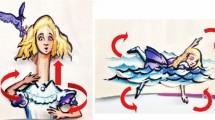Abstract
We present an interactive system that allows users to design original pop-up cards. A pop-up card is an interesting form of papercraft consisting of folded paper that forms a three-dimensional structure when opened. However, it is very difficult for the average person to design pop-up cards from scratch because it is necessary to understand the mechanism and determine the positions of objects so that pop-up parts do not collide with each other or protrude from the card. In the proposed system, the user interactively sets and edits primitives that are predefined in the system. The system simulates folding and opening of the pop-up card using a mass–spring model that can simply simulate the physical movement of the card. This simulation detects collisions and protrusions and illustrates the movement of the pop-up card. The results of the present study reveal that the user can design a wide range of pop-up cards using the proposed system.
Similar content being viewed by others
References
Elements of Pop Up: A Pop Up Book for Aspiring Paper Engineers
Furuta, Y., Kimoto, H., Mitani, J., Fukui, Y.: Computer model and mouse interface for interactive virtual origami operation. IPSJ J. 48(12), 3658–3669 (2007) (in Japanese)
Glassner, A.: Interactive pop-up card design, part 1. IEEE Comput. Graph. Appl. 22(1), 79–86 (2002)
Glassner, A.: Interactive pop-up card design, part 2. IEEE Comput. Graph. Appl. 22(2), 74–85 (2002)
Hendrix, S.L., Eisenberg, M.A.: Computer-assisted pop-up design for children: computationally enriched paper engineering. Adv. Technol. Learn. 3(2), 119–127 (2006)
Lee, Y.T., Tor, S.B., Soo, E.L.: Mathematical modelling and simulation of pop-up books. In: Proc. of Computers & Graphics 1996, vol. 20(1), pp. 21–31 (1996)
Li, X.Y., Shen, C.H., Huang, S.S., Ju, T., Hu, S.M.: Popop: automatic paper architectures from 3D models. ACM Trans. Graph. 29(4), 111 (2010)
Mitani, J., Suzuki, H.: Computer aided design for 180-degree flat fold origamic architecture with lattice-type cross sections. J. Graph. Sci. Jpn. 37, 3 (2003) (in Japanese)
Mitani, J., Suzuki, H.: Computer aided design for origamic architecture models with polygonal representation. In: Computer Graphics International 2004, Crete, Greece, 16–19 June, pp. 93–99 (2004)
Okamura, S., Igarashi, T.: An interface for assisting the design and production of pop-up card. In: Proc. of Smart Graphics 2009, pp. 68–78 (2009)
Author information
Authors and Affiliations
Corresponding author
Rights and permissions
About this article
Cite this article
Iizuka, S., Endo, Y., Mitani, J. et al. An interactive design system for pop-up cards with a physical simulation. Vis Comput 27, 605–612 (2011). https://doi.org/10.1007/s00371-011-0564-0
Published:
Issue Date:
DOI: https://doi.org/10.1007/s00371-011-0564-0




